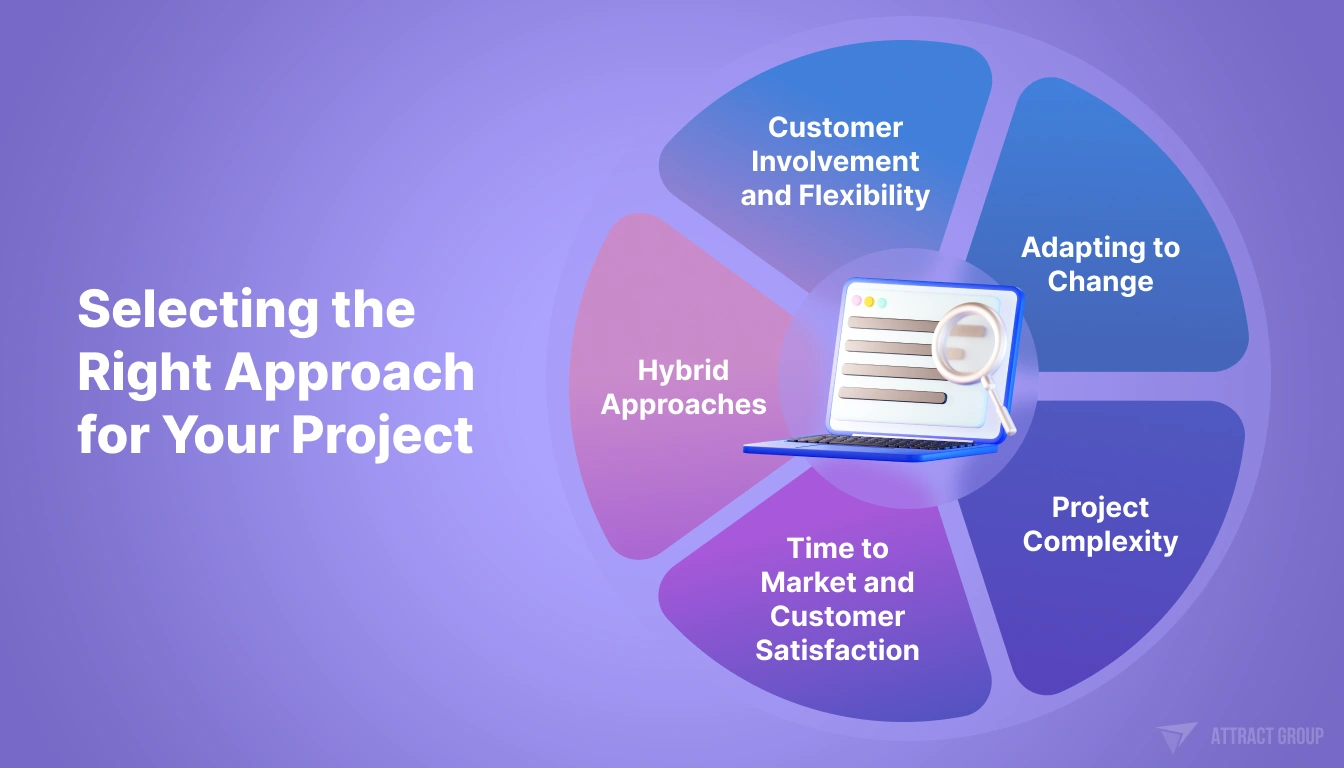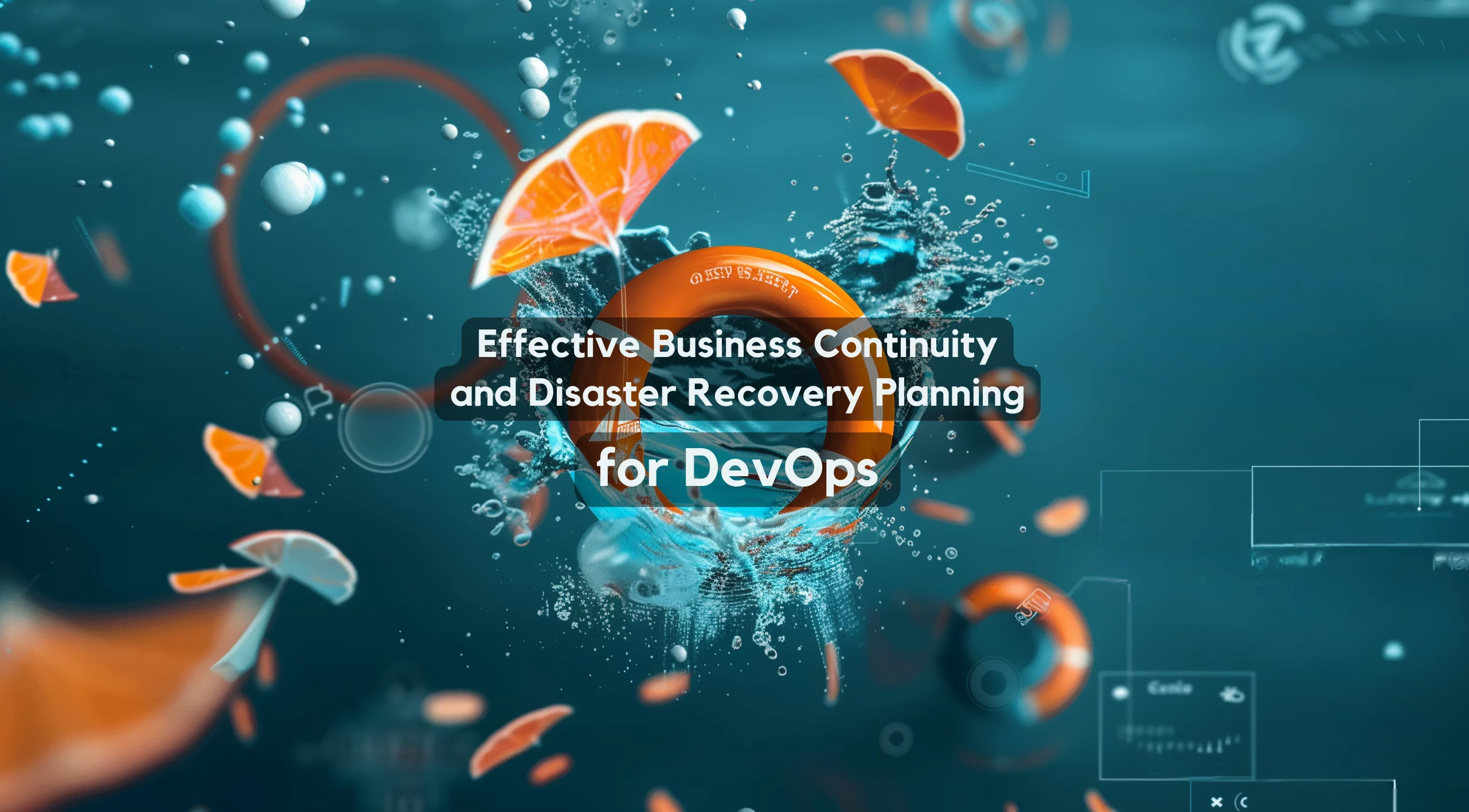Stuck in a whirlpool of project management methodologies? Feeling like a ship lost at sea? Statistics say you’re not alone. In fact, statistics say that for every 1 billion dollars invested in projects, almost $97 million is wasted due to poor project management.
Can you afford to let that 10% go to waste? Well, we hope not.

The truth is, many businesses try to skilfully navigate the waters of software development, but often fail because of so many options available.
That’s why we’re here to help.
The two most commonly used methodologies are undoubtedly Agile and Waterfall, but how do you choose which one’s right for you?
Read on more to find out, and while you’re at it, learn whether custom web development projects are worth it in 2023.
What Is Agile Methodology – Understanding The Basics

So what is agile methodology? We’ll explain in a way that’s easy to understand whether you’re a seasoned expert or a newbie starting out.
Here’s what you need to know:
Origins and Principles of Agile
Agile methodology, while popular today, didn’t emerge overnight. Its roots trace back to a need for increased flexibility and enhanced customer engagement in software development processes. Traditional Waterfall methodology often fell short in meeting these requirements, and Agile arose as a response to these limitations.
Agile methodology was conceived to address the challenges of lengthy development cycles and limited customer involvement. It aimed to bring adaptability and customer-centricity to the forefront of the software development process. This worked typically well for modern website development and mobile development where the requirements were ever-changing.
At the core of Agile lies the Agile Manifesto, a foundational document that encapsulates Agile’s values:
| Traditional Approach | Agile Approach |
| Processes and tools | Effective collaboration and open communication within development teams |
| Comprehensive documentation | Emphasis on practical results, favoring functional software |
| Contract negotiation | Ongoing customer engagement and collaboration |
| Following a plan | Agility in changing project dynamics, promoting adaptability |
Agile Methodologies and Frameworks
Agile methodology offers a range of methodologies and frameworks, each tailored to address specific project needs. These methodologies provide structure and guidelines for implementing Agile principles effectively.
- Scrum
Think of Scrum as a well-coordinated rugby team passing the ball down the field. It emphasizes teamwork, collaboration, and a series of short development cycles known as “sprints.”
- Kanban
Imagine a visual task board with sticky notes moving from “To-Do” to “In Progress” to “Done” as tasks are completed. Kanban is a visual and flexible approach to work management.
- Extreme Programming (XP)
Extreme Programming focuses on code quality and continuous feedback loops. It promotes practices like pair programming and comprehensive testing to ensure software excellence.
Key Characteristics of Agile Projects

Understanding Agile projects requires recognizing their defining features and operational philosophy.
- Customer Satisfaction
Agile emphasizes customer satisfaction by involving them throughout development, ensuring their needs and expectations are met.
- Empowered Development Teams
Agile trusts and empowers development teams to be self-organizing and cross-functional, reducing the need for hierarchical management.
- Incremental Progress
Agile emphasizes delivering small, functional project parts as quickly as possible, enabling stakeholders to see tangible results early on.
- Feedback Loops
Agile thrives on feedback. Frequent feedback loops facilitate course corrections, improvements, and alignment with evolving requirements.
- Accelerated Time to Market
Agile recognizes the importance of speed in software development. It facilitates faster time-to-market for products, a critical factor in today’s competitive landscape.
By grasping Agile methodology’s origins, principles, methodologies, and key characteristics, you’re better equipped to appreciate its significance and effectiveness in modern software development processes.
In the next section, we’ll explore the contrasting Waterfall methodology to provide a comprehensive perspective for making informed decisions in project management.
What Is Waterfall Methodology – A Structured Overview

In this section, we will delve into the Waterfall methodology, a historically significant approach to project management.
Origins and Historical Context of Waterfall
The Waterfall methodology, conceived in the 1950s, originally catered to engineering and construction projects before transitioning into software development. The core premise behind Waterfall is a meticulously planned, sequential process.
Waterfall Phases and Their Significance
A waterfall can be likened to a multi-course gourmet meal, each phase building upon the last:
- Requirements Phase
During this stage, all project requirements are meticulously documented, providing a comprehensive blueprint for development.
- Design Phase
Here, the architectural and user interface components are meticulously crafted in alignment with the established requirements.
- Implementation Phase
This is the stage where the software is constructed according to the pre-defined design specifications.
- Testing Phase
Rigorous testing is conducted to identify and rectify defects or irregularities in the software’s functionality.
- Deployment Phase
The final product is introduced to the end-users or stakeholders, marking the conclusion of the development cycle.
Advantages and Disadvantages of Waterfall Methodology
The agile model vs waterfall model argument can only be sorted out by weighing the pros and cons of each. Here’s both of those in a broader perspective:
Advantages of Waterfall
- Clear Project Roadmap: Waterfall offers a well-defined, linear path from initiation to completion, fostering transparency and predictability.
- Robust Documentation: A comprehensive documentation process ensures meticulous tracking and a detailed project history.
- Suitability for Stable Projects: Waterfall excels when project requirements remain relatively static.
Disadvantages of Waterfall
- Rigidity: The method’s inflexibility can be likened to a one-way street; once you proceed, backtracking is challenging.
- Limited Customer Involvement: Stakeholder engagement primarily occurs at the project’s culmination, potentially leading to misalignments with evolving expectations.
- Challenges with Evolving Projects: Waterfall’s rigidity may impede adaptation when dealing with dynamic project scopes.
Overall, the Waterfall methodology offers a structured and systematic approach to software development, characterized by its well-defined phases and documentation. However, it is essential to consider its limitations, particularly in contexts that demand flexibility and ongoing customer involvement.
When To Use Agile Vs Waterfall Methodology
When evaluating the Agile and Waterfall methodologies, it’s essential to understand how they compare in various aspects of the software development process. In this section, we’ll delve into five key areas, breaking them down to shed light on the nuances of each approach.
1. Project Planning and Initiation
Agile Approach
The Agile methodology begins with a more flexible and adaptable approach to project planning. Agile teams often embark on a project with a broad plan, allowing room for adjustments. Agile thrives on customer involvement right from the start, enabling iterative progress. This approach is particularly suitable when the project is uncertain, as it accommodates exploration and discovery.
Waterfall Approach
In contrast, the Waterfall methodology resembles a meticulously choreographed dance, where every step is planned. It emphasizes the importance of a well-defined project roadmap from the outset. Waterfall is most effective for projects with clearly outlined requirements, where changes to the plan are discouraged.
It ensures that each phase falls neatly in line with the one before, offering a structured path toward project completion.
2. Requirements Gathering and Documentation
Agile Approach
The Agile approach maintains fluidity in requirements gathering. It prioritizes interactions and collaboration over rigid processes and tools, aligning with the Agile Manifesto’s principle of valuing “Individuals and interactions over processes and tools.”
Agile encourages constant feedback loops and adjustments, aiming to deliver working software early in development. This approach suits projects where frequent customer input and satisfaction are paramount.
Waterfall Approach
On the other hand, the Waterfall methodology heavily emphasizes comprehensive documentation upfront. It’s akin to writing an intricate script before shooting a movie. Waterfall meticulously plans and documents every project aspect, which proves advantageous when a robust foundation is essential.
However, this rigorous documentation process may not align with rapid project delivery or immediate end-user engagement.
3. Project Execution and Management
Agile Approach
Agile project execution revolves around the “here and now.” It follows an iterative and incremental approach, with development teams tackling small portions of work in cycles known as iterations.
Each iteration yields working software, fostering adaptability and responsiveness to changing circumstances. Agile delivers a swift time-to-market and facilitates smooth adjustments along the way.
Waterfall Approach
The Waterfall methodology adheres to a linear progression, much like a cascading waterfall. Each project phase flows seamlessly into the next, following a predetermined path. Once initiated, altering the course can be challenging.
This approach is well-suited for projects with well-established requirements, and changes mid-course are discouraged. Waterfall’s strengths lie in its predictability and the assurance that the original plan will be executed methodically.
4. Flexibility and Adaptability
Agile Approach
Agile shines when it comes to flexibility and adaptability. Its iterative nature allows teams to pivot swiftly in response to evolving project needs or shifting priorities.
Agile processes encourage continuous improvement and provide the latitude to fine-tune project objectives as the development process unfolds.
Waterfall Approach
In contrast, with its rigid sequential approach, the Waterfall methodology tends to resist significant deviations from the original plan. Changes can be cumbersome and may disrupt the established workflow. Waterfall excels when stability and adherence to predefined project parameters are crucial.
5. Risk Management
Agile Approach
Agile’s approach to risk management integrates it seamlessly into the development process. Agile teams can promptly identify and address potential issues by delivering working software early and frequently.
Continuous feedback loops and iterative development cycles mitigate risks by providing opportunities for course correction.
Waterfall Approach
Waterfall’s risk management approach is more traditional, with risk assessment and mitigation strategies typically defined upfront in the planning phase.
While this method can effectively manage known risks, it may struggle to adapt to unforeseen challenges that surface later in the project’s lifecycle.
As we explore these aspects of Agile and Waterfall methodologies, remember that choosing between them should align with your project’s unique needs and constraints. These methodologies each bring their own set of strengths and limitations to the table, and selecting the right one can significantly impact your project’s success.
Selecting the Right Approach for Your Project
When it comes to project management, choosing the right approach is crucial to picking the perfect tool for the job. It can make all the difference between soaring success and costly chaos.
This section will dive into the factors that will help you decide whether Agile or Waterfall is your trusty sidekick.

1. Customer Involvement and Flexibility
One of the shining advantages of Agile is its unwavering focus on customer involvement. Agile doesn’t just want to meet customer needs; it craves to exceed them. The Agile approach encourages customers to be part of the development process, providing continuous feedback loops.
Waterfall, on the other hand, often keeps customers at arm’s length until the end, which can lead to surprises that aren’t always delightful.
2. Adapting to Change
Life is full of surprises, and so is software development. Agile’s mantra, as the Agile Manifesto dictates, is to accept and accept change gracefully. When priorities shift, or new requirements emerge mid-project, Agile development teams are nimble enough to pivot without capsizing the ship.
In contrast, the rigid structure of the Waterfall methodology can make change feel like turning a cruise liner—it takes time and effort.
3. Project Complexity
The Waterfall model can offer stability and predictability for projects where the path ahead is clear and the scope is well-defined. However, in today’s dynamic world, many projects are like navigating a maze in the dark.
Agile thrives in such complexity. Its iterative and incremental approach allows development teams to tackle one piece at a time, delivering working software quickly and ensuring it aligns with evolving customer needs.
4. Time to Market and Customer Satisfaction
Agile shines brightly in the race to get your product to market swiftly. With shorter development cycles, it can give you the edge. This rapid pace also translates into more frequent customer feedback, increasing customer satisfaction.
Waterfall, with its sequential phases, can lag in the “time to market” department, potentially leaving customers waiting for their solutions.
5. Hybrid Approaches
Sometimes, one size doesn’t fit all. If your project’s landscape is a mix of clear and foggy, you can embrace hybrid approaches that combine Agile and Waterfall elements. This way, you can enjoy the best of both worlds—Agile’s flexibility and Waterfall’s structure.
Transitioning between Agile and Waterfall
So, you’ve decided to take the plunge and switch project methodologies. It’s like stepping from one world into another, but don’t worry, we’ve got your back! Transitioning between Agile and Waterfall methodologies can be a game-changer for your project’s success.

Here’s your roadmap:
| Step | Description |
|---|---|
| 1. Assess the Situation | Start by evaluating where your project stands. Are you in the middle of a Waterfall-driven marathon or deep into an Agile sprint? Knowing your current position is critical to a smooth transition. |
| 2. Identify Pain Points | Pinpoint challenges with your current methodology. Is it inflexibility in Waterfall or too much uncertainty in Agile? Acknowledging these pain points is your ticket to improvement. |
| 3. Set Clear Goals | Define what you want to achieve with the switch. Align your goals with the advantages of Agile or the structured approach of Waterfall. |
| 4. Plan the Transition | Develop a plan outlining how to migrate from one methodology to another. Consider training teams, adapting processes, and communicating the change. |
| 5. Execute with Care | Implement the transition gradually. Ensure everyone is on board and understands their roles. Harmony is crucial! |
| 6. Embrace Flexibility | Be ready for bumps along the way. Agile encourages adaptability, so tweak your approach as needed. |
| 7. Measure and Iterate | Continuously monitor progress, gather feedback, and make improvements. This agile approach to transitioning will lead to better customer satisfaction and project success. |
Remember, it’s not about Agile vs. Waterfall; it’s about choosing the correct methodology for your project’s unique needs. Transitioning can breathe new life into your software development lifecycle, ultimately improving your time to market and customer satisfaction.
Key Takeaways
In conclusion, when it comes to software development, Agile and Waterfall are two distinct methodologies. With its customer involvement and feedback loops, Agile shines in its ability to adapt swiftly to changing requirements.
It aligns perfectly with the Agile Manifesto and encourages close collaboration within development teams.
On the flip side, with its structured development process, the Waterfall methodology suits projects with well-defined requirements.
Each approach in the agile vs waterfall argument has it’s own benefits and detriments and the choice depends on the project’s nature and objectives. Though, In today’s fast-paced world, Agile often wins the race with its shorter time to market, as seen in extreme programming and other Agile methodologies.
Ultimately, it’s about customer satisfaction and delivering working software efficiently, making Agile project management an appealing choice for modern development lifecycles.
FAQs: Agile vs. Waterfall
1. What are Agile and Waterfall methodologies?
- Answer: Agile and Waterfall are two distinct project management methodologies. Agile focuses on iterative development with regular feedback, while Waterfall follows a linear, sequential approach.
2. How do Agile and Waterfall differ in their approach?
- Answer: Agile promotes continuous releases that incorporate customer feedback, allowing for adjustments during each iteration. Waterfall, on the other hand, requires the team to complete each project phase before moving on to the next.
3. What is the Waterfall methodology?
- Answer: Waterfall is a linear project management approach where each phase of the project must be completed before progressing to the next. It’s ideal for projects with clear and unchanging requirements.
4. What is Agile methodology?
- Answer: Agile is an iterative approach to project management, emphasizing rapid iteration, autonomy, and flexibility. It divides work into “Sprints” or time-based bursts of activity.
5. When should Agile vs. Waterfall be used?
- Answer: Agile is suitable for projects that prioritize learning and adaptability, while Waterfall is ideal for large, complex projects with specific requirements.
6. What are the key differences between Agile and Waterfall?
- Answer: The main differences pertain to oversight, processes, documentation, and timing. Agile is more flexible and iterative, while Waterfall is linear and sequential.
7. Are there any benefits to using Agile?
- Answer: Agile offers flexibility, promotes rapid iteration, and allows for continuous feedback. It’s also more adaptable to changes during the development process.
8. What are the advantages of the Waterfall methodology?
- Answer: Waterfall provides a clear project plan from start to finish, establishes requirements early on, and follows a structured workflow.
9. Can Agile and Waterfall coexist in the same organization?
- Answer: Yes, while they represent different approaches, both methodologies can coexist within the same organization, depending on the nature of the projects.
10. How does client involvement differ in Agile vs. Waterfall?
- Answer: In Agile, there’s frequent stakeholder interaction and feedback incorporation. In Waterfall, once the end goal is established, there’s limited client involvement until the project’s completion.
11. Which methodology is more popular in software development?
- Answer: Both methodologies are popular, but Agile has gained significant traction in recent years due to its adaptability and iterative nature.
Some images presented in this article made by www.freepik.com









